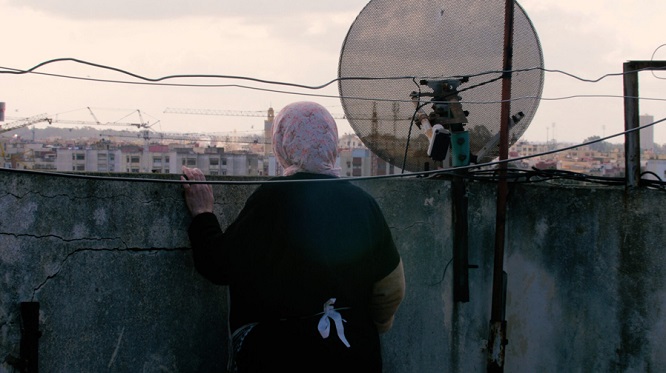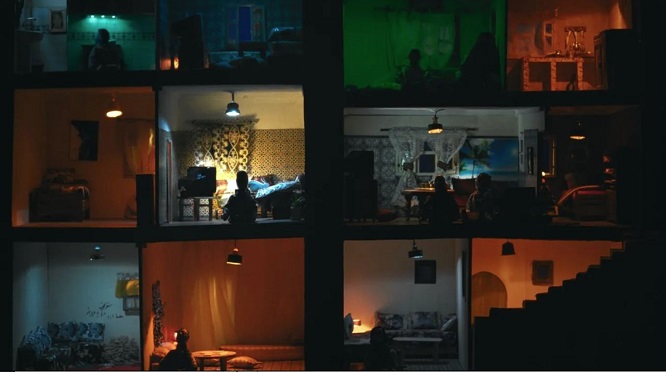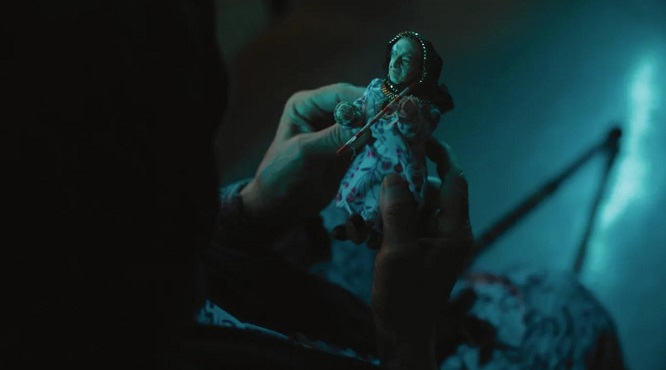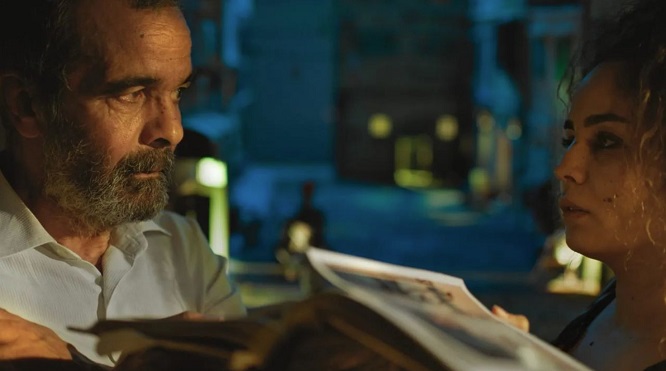
|
Panorama-cinéma is back at TIFF after a four-year absence! Our columnist Mike Hoolboom, one of the most famous and lovely experimental filmmakers in the country, will share his thoughts about some films from the Festival lineup. Don't miss this chance to attend the event by proxy, but mostly to bask in Mike's unique and rousing verve, which will undoubtedly manage to fill your mind with images both inspiring and horrendous, as if you were attending the crowded Lightbox screenings in person. — Olivier Thibodeau, editor Festivals section |

:: Kadib Abyad (Mother of All Lies, Asmae El Moudir, 2023) [Insight Films / Red Sea Film Festival Foundation]
When the director strides to the stage, every article of her clothing twinkles and shines, right down to her shoes. She pauses to take a selfie with the TIFF festival audience saying, “It took me ten years to make this film, so now I take my time.” Welcome to Asmae El Moudir, winner of the Best Director in Cannes’ Un Certain Regard section, in May 2023. Her homemade miracle doc Kadib Abyad (The Mother of All Lies) has just been chosen to represent Morocco for this year’s Best International Feature Film Oscar.
In the house where I grew up, I was looking for missing things.
One of the astonishments of this intimate encounter is that it is a home movie. The director’s parents, grandmother and neighbours make up the central cast of the film. They are tasked with nothing less than recounting the secret history of their country during the Years of Lead (1960s to the 1980s). Six years of a debilitating colonial war in the Spanish Sahara bled the economy, causing catastrophic price hikes for even the most basic foods (flour, oil, butter). The Casablanca bread riots of 1981 filled the streets with protesters, many of them young and poor. They were met by soldiers ordered to massacre them.
I couldn’t make this film without an archive, so I had to invent one.
Early in the film, a dream sequence replays the director’s oldest wish of wishes. It shows Asmae flying to Hawaii in order to have her picture taken. Every photo studio in Casablanca offers Hawaiian backdrops; for the director (and her neighbours), “Hawaii” is short form for memory itself, a storage vault she cannot locate physically because all evidence has disappeared. The only childhood picture Asmae has of herself shows a little girl in a nursery playground, but she is certain the child is not her. It mystified her for many years until she learned that her grandmother’s terror led her to burn all of the family photos.
Her father Mohamed El Moudir’s dream was to play goal for the local football team. But one morning, when he arrived early at the field for practice, there was a hole in place of the field, and a newly painted fence forbidding access. His cherished hope had become a graveyard, a truth he wouldn’t discover until bodies were dug up many years later. He decided to become a builder, learning how to work with wood and lay tiles. As it turned out, he built many of the houses in his neighbourhood. And in a strange twist that only cinema could make possible, he is offered a second chance, to build his neighbourhood again, alongside his filmmaker daughter.


[Insight Films / Red Sea Film Festival Foundation]
Impossibly, ingeniously, the filmmaker and her father begin to reconstruct the street they lived on, house by house, even furnishing the rooms with material scraps and miniature painting and photo reproductions. Likenesses of neighbours are carved out of wood, along with themselves of course. The set is large enough to allow the camera to pan down its walls, or move through its streets. Exquisitely simple lighting effects add substantially to the dramatic import of these scenes. Flickering police lights behind a window, sparklers cast magic across a house façade, a child’s birthday candle lights up her grandmother doll’s worn expression.
How do we invent stories when we have no evidence?
Fatima was just 12 years old when she left her house to join friends on the streets. Within hours, she was shot dead by soldiers. The family was alerted by neighbours who brought her body home. But soldiers tracked them down, and her body was taken from them and disappeared. It is likely she is one of the hundreds of bodies unearthed in the former football field, though no one knows for sure.
There are many sequences I couldn’t show because things didn’t go well between us.
The forbidding matriarch of the family is Zahra, the filmmaker’s grandmother. Upset over a portrait that is being painted of her, she smashes it to pieces with her cane. She is a glowering misanthrope, resisting the work of memory at every turn. After pleading with her for three years to join the family in this collective act of retrieval, the director finally decided on an actor to replace her. But her grandmother called her at the last moment. “Do you really think you can find someone who can play me? This is how you’re going to destroy my power.” There is little doubt that her immovable presence adds a hefty counterweight to the scarred optimism that lights up the rest of the family. As the director noted during the Q&A after the TIFF screening: “I was lost making this film. My family was afraid to talk about the past so I had to change the way our stories could be told. This was the work.”
This is what film is for me, the interactions of my family.

:: Asmae El Moudir and her father [Insight Films / Red Sea Film Festival Foundation]
Their neighbour Abdallah Zouid produces the film’s centrepiece in the most riveting scene committed to film this year. Using a desk lamp, a few dolls, and a wooden box to represent a prison, he recounts how soldiers broke down the door of his house in 1981 and began beating him in front of his family. He had attended no demonstrations, and was involved with no political organizing. His “arrest” was an accident, a mistake. No matter. They brought him to prison where he was met by a long line of guards who beat him soundly. Then, he was pushed into a terrifyingly overcrowded prison cell, where temperatures rose until many died. He crawled out of the cell and was ordered by a soldier to help drag the bodies out. He refused and, for this, was mercilessly beaten again. He watched as soldiers dragged out men and children, most already dead. One man, a friend and neighbour, saw his boys lying dead on the ground, and began to pace back and forth with his hands behind his back, unable to talk.
Abdallah speaks with his whole body, because his whole body is memory. He returns to the most painful moment of his life, and the life of his country, as an offering to his neighbours and to all of us.
After the film, Asmae told us, “For me, this scene was the film, to give space to Abdallah. He never speaks about this. At one point, he said he had to go out for a smoke. I asked everyone not to speak to him during this break. I wasn’t sure if he was going to come back, it was so intense. If he came back, we would continue, but if he didn’t, that was also fine of course. There would be no second chances, no way we could ask him to do this again. But he came back. When the film was finished, he travelled with us, with my family and me, to Cannes. After he saw the film there and the reception it received, he said, ‘I am another Abdallah today.’”
All quotations in italics are from Asmae El Moudir’s after-screening discussion at TIFF, September 15, 2023.
*
Mike Hoolboom began making movies in 1980. Making as practice, a daily application. Ongoing remixology. Since 2000 there has been a steady drip of found footage bio docs. The animating question of community: how can I help you? Interviews with media artists for 3 decades. Monographs and books, written, edited, co-edited. Local ecologies. Volunteerism. Opening the door.

 |
envoyer par courriel | 
| imprimer | Tweet |
